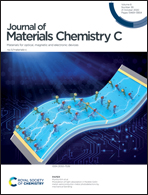High fluorescence LaOBr/coumarin organic–inorganic composite nanomaterials for ultra-sensitive Fe3+ sensing, fluorescence imaging and water-based ink anti-counterfeiting applications†
Abstract
The detection of metal ions such as Fe3+ ions at the cellular level is of vital importance for monitoring life activities and disease diagnosis. Coumarin-based molecules are uniquely selective fluorescence probes for detecting Fe3+ ions; however, due to their lower water solubility, applying them in biological detection is a bottleneck problem. Herein, a centrally hydrophobic/externally hydrophilic strategy is proposed and a novel coumarin-based fluorescence probe was successfully synthesized by using LaOBr via a nucleophilic substitution reaction. The hydrophobic part of each coumarin molecule faces inward, and the hydrophilic part (iron-ion-capturing group) faces outward, allowing each coumarin molecule to be fully stretched. Compared with the coumarin-based N-[2-hydroxy-1,1-bis(hydroxymethyl)ethyl]-7-hydroxycoumarin-3-carboxamide (DAT) solution, the water solubility of the LaOBr/DAT composite solution was greatly improved, with enhanced fluorescent properties and detection performance. In a water solvent, the detection limit of the composite considerably improved from 300 nM to 440 pM, and the composite demonstrated better stability and selectivity for detecting Fe3+. The composite probe was applied in Fe3+ detection at the cellular level and in invisible anti-counterfeiting. This material design is of universal significance for improving the performance of other organic molecules.



 Please wait while we load your content...
Please wait while we load your content...